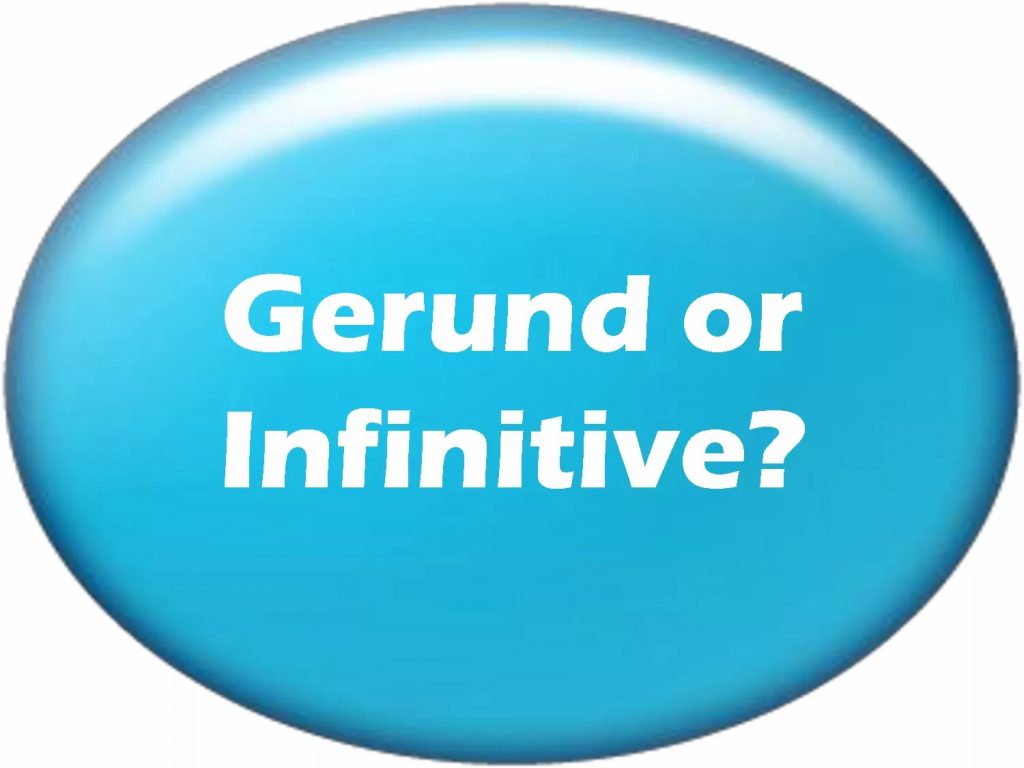Verb + to-infinitive
Some verbs can be followed only by a ‘to’-infinitive:
Some verbs with this pattern:
- verbs of thinking and feeling: decide, expect, hope, learn, seem, want, plan, intend, plan
- verbs of saying: agree, promise, refuse
- other common verbs: afford, appear, choose, fail, manage, wait
- We agreedto go to the cinema together with Ann.
- Steffany decidedto take a taxi, because it was late.
- I promiseto follow your piece of advice.
- Last year Jack learnedto play table tennis.
- She feels offended and she doesn’t wantto see him.
Verb + object + to-infinitive
Some verbs can be followed by an a object (a noun or a pronoun) and a to-infinitive.
Common verbs with this pattern:
- verbs of wanting or liking: expect, intend, would prefer, want, would like
- verbs of saying: advise, ask, encourage, invite, order, persuade, remind, tell, warn
- other common verbs: allow, enable, force, get, teach
Verb + gerund
Some verbs can be followed only by a gerund:
Some verbs with this pattern:
- verbs of liking and disliking: enjoy, like, love, hate, dislike, fancy
- phrases with ‘mind’ – like ‘I don’t mind‘
- verbs of saying and thinking: admit, consider, deny, imagine, remember, suggest, recommend
- other common verbs: avoid, begin, finish, keep, miss, practise, risk, start, stop
- I enjoy drinking my coffee in the morning.
- Yesterday we discussed going to Italy on vacation.
- Your drawings are quite good, keep on practicing.
- Peter tried to avoid answering his father’s questions.
- Have you ever consideredcrossing that beautiful lake on a raft?
Some verbs (e.g. mind, imagine, can’t stand, dislike, involve, miss, put off and risk) can be used with an subject before the gerund. If the subject is a pronoun, it is in the object form (me, him, her, us, them):
- We just couldn’t imagine Robert making a speech.
- Do you mind me sitting here while you’re working?
- I don’t want to risk her losing her job.
Tips to use verbs with infinitive and gerund
Here are some tips to remember.
1. Gerunds are mostly used when actions are real, fixed, or completed. Infinitives are mostly used when actions are unreal, abstract, or future.
- I enjoy cooking.
- He wants to swim.
2. After a preposition, you almost always will find a gerund.
- She is afraid of flying.
3. When you are talking about an activity, you usually use a gerund.
- I quit smoking.
- Let’s go shopping.
Verb + infinitive or gerund with no change in meaning
Some verbs can be followed either by the infinitive or the gerund without any change in meaning:
begin, bother, continue, hate, intend, like, love, prefer, start
- Suddenly it started raining. = Suddenly it started to rain.
- Michael intends buying a bicycle. = Michael intends to buy a bicycle.
- The boy continued playing with his dog. = The boy continued to play with his dog.
- Margaret prefers meeting with her friends in a mall. = Margaret prefers to meet with her friends in a mall.
The verbs ‘hate’, ‘like’, ‘love’ and ‘prefer‘ can be followed either by ‘-ing’ or a ‘to’-infinitive. The difference in meaning is often small. The ‘-ing‘ form emphasizes the verb itself. The ‘to‘-infinitive puts the emphasis more on the preference for or the result of the action.
Compare:
| Gerund | Infinitive |
| I love cooking Italian food. (emphasis on the process itself and enjoyment of it) | I like to drink coffee in the morning, and tea in the evening. (emphasis more on the preference or habit) |
| She hates washing the dishes. (emphasis on the process and no enjoyment of it) | I hate to be the only person to attend. (emphasis on the result: I would prefer not to be in that situation) |
| Note: When ‘hate’, ‘like’, ‘love’ and ‘prefer’ are used with would or should, only the ‘to’-infinitive is used: |
- He’d love to find some quiet place to live. NOT:
He’d love finding some quiet place to live. - Would you like to go to the party on Saturday?
Verb + infinitive or gerund with change in meaning
But some verbs can be followed either by the infinitive or the gerund with a certain change in meaning:
forget, regret, remember, stop, try, need, go on
Compare:
| Gerund | Infinitive |
| Mike regretssaying what he said to his teacher. (he did that and now he’s sorry about it) | We regretto inform you that the train will be 2 hours late. (we are sorry that we have to say that) |
| I know Jane, I remembertalking to her yesterday. (I talked to Jane and now I remember that fact) | Yesterday I met Jane and I rememberedto talk to her. (I’d planned to talk to Jane, so I did not forget to do that when I met her) |
— Some verbs connected with feeling, hearing and seeing can be used with gerund or with an infinitive without to:
feel, notice, see, hear, watch
— When used with gerund, these verbs emphasize the action in progress. When they are used with an infinitive without to, they emphasize the action as a whole, or as completed.
Compare:
| Gerund | Infinitive |
| She heardpeople shouting in the street. (emphasizes the continued or repeated action) | I heard someone shout ‘Help!’, so I ran outside. (emphasizes the whole event happened once) |
| I saw her crossing the street. (emphasizes the crossing as it was happening) | I saw Philip cross the street. (emphasizes the whole event from start to finish) |

